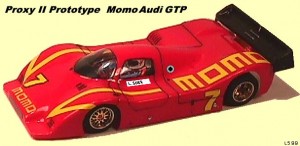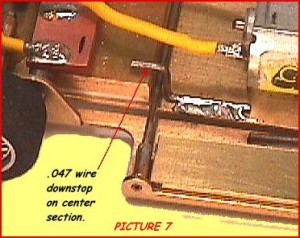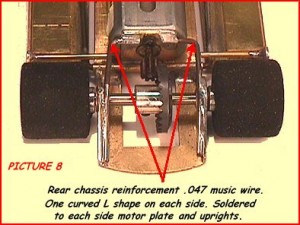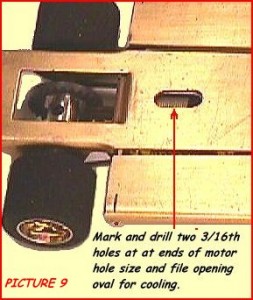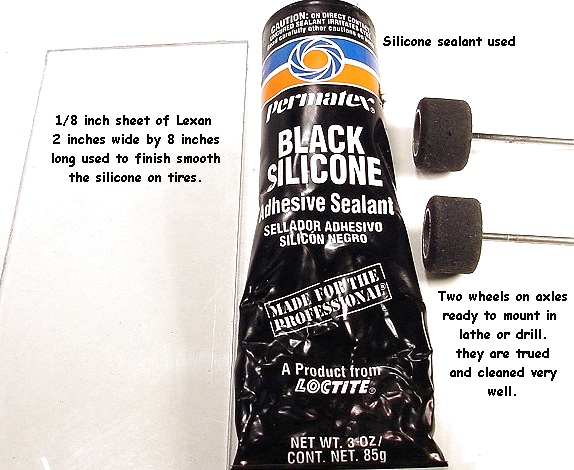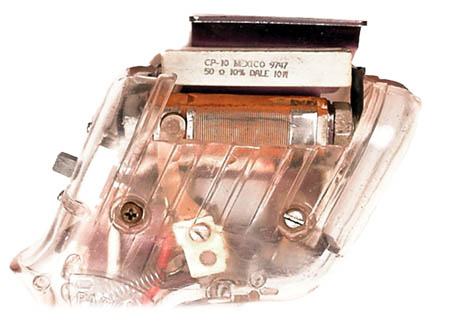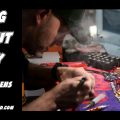PROXY RACE II PROTOTYPE CAR BUILDING
By Larry Shephard 8-22-99
Introduction
Some have said that they would like to enter the Proxy Race II but they only feel comfortable entering the production class because they feel unable to build a car that would be competitive in the prototype class because of the chassis complexity. Ahhhhhhhh – but that is not the case timid ones. You can build something fairly simple that can be a good competitor. Follow along and see what you think of this prototype project car.
A few years ago, I built some fun fast cars using the Parma Womp chassis as a starting point. It’s sturdy, approximately the right size and is easily modified into something much more able to compete. The following picture shows the brass womp with the longer wheel base option. It has been cut to remove the pans and to begin construction of an Iso Fulcrum chassis for the prototype class. This chassis type lets the chassis behave much like a tripod car but allows the front wheels to touch and roll for good looks. Upon hitting a bump they will rise up away from the bump not affecting the chassis center section. In corners they will rise up again out of the way quickly. This way they do not apply leverage or stress to the handling of it as a tripod. I have had much success with this type chassis.
STEP ONE Mark the 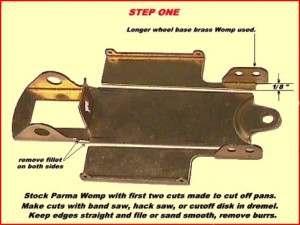 chassis with a scriber or fine point felt pen leaving about 1/8 inch on the inside of the front axle upright straight back parallel to the center line. This leaves the center section of the chassis about one inch wide. Draw the lines on the top of the chassis, and if you have one, use a band saw to cut the pans off. If using a hack saw or a Dremel tool with a cut off disk, mark it on the bottom. Cut as straight as you can. File or sand the edges smooth and remove any burrs. Take your time, be careful and wear eye protection at all times. Cut a couple pieces of .062 music wire about 2.5 inches long as alignment spacers. Set aside. Remove the chassis fillets at the rear of the chassis near the motor mount. With a small round file, file a channel to fit the 3/32nd round hinge tube we will make up. It must fit up tight against the rear of the motor mount at the bottom.
chassis with a scriber or fine point felt pen leaving about 1/8 inch on the inside of the front axle upright straight back parallel to the center line. This leaves the center section of the chassis about one inch wide. Draw the lines on the top of the chassis, and if you have one, use a band saw to cut the pans off. If using a hack saw or a Dremel tool with a cut off disk, mark it on the bottom. Cut as straight as you can. File or sand the edges smooth and remove any burrs. Take your time, be careful and wear eye protection at all times. Cut a couple pieces of .062 music wire about 2.5 inches long as alignment spacers. Set aside. Remove the chassis fillets at the rear of the chassis near the motor mount. With a small round file, file a channel to fit the 3/32nd round hinge tube we will make up. It must fit up tight against the rear of the motor mount at the bottom.
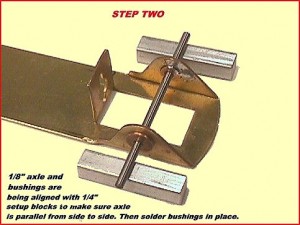 STEP TWO This concerns aligning the rear axle and bushings. Installing your 1/8 inch axle bushings is important. Set the frame on a good flat surface and slip the 1/8 inch bushings in the chassis and slide in the axle and check for a smooth fit. To check that you have the right height from side to side, use some 1/4 inch blocks or spacers under each axle end. I use some 1/4 inch square aluminum blocks I cut from a longer piece I got at a Home Depot metals section. They are close enough that when the axle on each side is flush on top of each block, it is aligned. You want the axle to be aligned with the motor bushing in the motor mount plate. You may have to file the holes up or down a bit to get a better alignment. When they are where you want them, apply some paste such as “NoCorrode” and apply good solder with enough heat to allow the solder to flow and become shiny. Try to use acid flux only when soldering to steel parts. Keep any solder off the outside edges of the bushings to avoid interference with the wheel hubs when mounted.
STEP TWO This concerns aligning the rear axle and bushings. Installing your 1/8 inch axle bushings is important. Set the frame on a good flat surface and slip the 1/8 inch bushings in the chassis and slide in the axle and check for a smooth fit. To check that you have the right height from side to side, use some 1/4 inch blocks or spacers under each axle end. I use some 1/4 inch square aluminum blocks I cut from a longer piece I got at a Home Depot metals section. They are close enough that when the axle on each side is flush on top of each block, it is aligned. You want the axle to be aligned with the motor bushing in the motor mount plate. You may have to file the holes up or down a bit to get a better alignment. When they are where you want them, apply some paste such as “NoCorrode” and apply good solder with enough heat to allow the solder to flow and become shiny. Try to use acid flux only when soldering to steel parts. Keep any solder off the outside edges of the bushings to avoid interference with the wheel hubs when mounted.
STEP THREE This will invol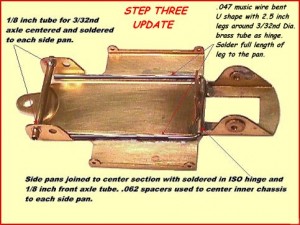 ve making the Iso hinge. The hinge is made of a piece of 3/32nd brass tubing. It is cut about 1/16th inch longer than the width of the center chassis. The inside diameter of this tubing is .062. To allow some rear chassis flex, we will use .047 diameter music wire to allow some movement. Take the music wire and make a right angle bend about 2/1/2 inches long. Slip the brass tube on the long end of the bent wire. Move it all the way down to the bend. Using pliers, make another right angle bend around the open end of the tube leave a little slack in the bend so there is some side to side movement of about 1/16th inch total. This now makes a U shaped wire with the brass tube held captive between the two bends. Make sure the wire can rotate freely inside the tube and has not gotten locked up by the tube being crimped.
ve making the Iso hinge. The hinge is made of a piece of 3/32nd brass tubing. It is cut about 1/16th inch longer than the width of the center chassis. The inside diameter of this tubing is .062. To allow some rear chassis flex, we will use .047 diameter music wire to allow some movement. Take the music wire and make a right angle bend about 2/1/2 inches long. Slip the brass tube on the long end of the bent wire. Move it all the way down to the bend. Using pliers, make another right angle bend around the open end of the tube leave a little slack in the bend so there is some side to side movement of about 1/16th inch total. This now makes a U shaped wire with the brass tube held captive between the two bends. Make sure the wire can rotate freely inside the tube and has not gotten locked up by the tube being crimped.
Put the chassis parts on a flat surface and align the center sections and the pans as in the first picture. Put the two .062 music wire spacers between the pans and the center section to allow a .062 space between the center section and each pan piece. Move back or forward till you get the wheel base you want. Put the rear hinge on the chassis with the tube set down flat on the chassis just to the rear of the motor mount. The arms of the U shaped wire should rest on the pans. Cut a piece of 1/8 inch brass tubing longer than the front axle pans and slip in the front axle holes. Line everything up and apply flux and solder the front tube to the uprights. Make sure the chassis is still aligned and solder the hinge tube in place. Solder on each side of the tube to the bottom of the chassis and motor mount plate. Also solder it to the motor mount plate right under the motor bushing hole. Solder the music wire U arms of the hinge to the full length of the pans on each side, one at a time, checking the alignment after each solder. Now the chassis should be aligned and the pans will be able to pivot up and down at the rear hinge.
 STEP FOUR Things are now coming together. Fit the motor to the motor mount plate. I had to straighten mine and make sure it is vertical. Use the standard small short motor mount screw to pull the motor inline. Make sure the motor sits flat with no space under front or rear. It should also sit parallel to the chassis center line. I used a Cox 27 tooth crown gear with a 7 tooth pinion. Solder the pinion on when you decide how far it should go on the motor shaft to align with the crown gear.
STEP FOUR Things are now coming together. Fit the motor to the motor mount plate. I had to straighten mine and make sure it is vertical. Use the standard small short motor mount screw to pull the motor inline. Make sure the motor sits flat with no space under front or rear. It should also sit parallel to the chassis center line. I used a Cox 27 tooth crown gear with a 7 tooth pinion. Solder the pinion on when you decide how far it should go on the motor shaft to align with the crown gear.
The chassis for the proxy race will need to be on the heavy side to handle the relatively tight track at Daytona West. The finished car weighs in at 125 grams or about 4.4 ounces.The weight needs to be to the front of the chassis. This helps keep the guide shoe down in the slot. I picked up some 1/8 inch thick brass stock and some .062 brass plate at a hobby shop. I prefer to use brass for weight instead of lead. It looks better and comes in sufficient thickness to come close to lead weight for the same size piece. The front weight used is 1/8 inch thick cut 1 inch wide by 3/4 inch long. The two side pan weights are .062 plate cut to 1 and 3/8 inch long by 3/8 inch wide. They are secured in place with thin double stick carpet tape. I would have used some thin black tape that you can find at a auto parts store but mine was out when I looked. It sticks better and is thinner which helps keep the weight and the Center of gravity down lower.
Next are the body mounts. I used Parma or DRS stainless steel .050 diameter tubing for the front body mount. The holes in the chassis are .062. The difference in diameter gives the body a slight bit of movement to isolate it from the chassis and allow better handling. The tubing has .062 by 3/8 inch brass tubing soldered to each side so it cannot slide out of the chassis holes. Don’t get them too tight so they have the slight bit of movement needed. The rear mounts have to be short to allow room for the motor. They are soldered to the pans and to the Iso hinge arms on each side.
 STEP FIVE Now we focus on the front end. The second brass tube shown is cut to the width of the front uprights. Solder it in place. This is needed as a chassis connector and stiffener. Now we can split the front axle tube in half and shorten each side to about 1/2 inch. We need to make up some stub axles from a 3/32 axle. Cut them about 1 inch long. Cut some 1/8th tubing into small collars about 1/16th inch long. Slip the collars on each stub axle from the inside of the chassis. Leave a bit of the axle showing beyond the collar end and solder the collars on the axle ends. This prevents the axle from coming out of the tube but allows each axle to rotate individually. This works best when the car is cornering and the inside wheel wants to drag. If both wheels are attached, it’s a double drag you don’t need. Also the turning radius each wheel wants to travel is a different distance around the corner. One wheel has to slip if they are tied together. There should be enough axle showing on the outside of the chassis so that the wheels used will seat full depth of the hub with out binding against the chassis. Space them out to meet the 2.5 inch proxy rule if your body will allow. I used Pro track hard fronts trimmed to .750 Dia. and narrowed to .375 per rules for Prototype.
STEP FIVE Now we focus on the front end. The second brass tube shown is cut to the width of the front uprights. Solder it in place. This is needed as a chassis connector and stiffener. Now we can split the front axle tube in half and shorten each side to about 1/2 inch. We need to make up some stub axles from a 3/32 axle. Cut them about 1 inch long. Cut some 1/8th tubing into small collars about 1/16th inch long. Slip the collars on each stub axle from the inside of the chassis. Leave a bit of the axle showing beyond the collar end and solder the collars on the axle ends. This prevents the axle from coming out of the tube but allows each axle to rotate individually. This works best when the car is cornering and the inside wheel wants to drag. If both wheels are attached, it’s a double drag you don’t need. Also the turning radius each wheel wants to travel is a different distance around the corner. One wheel has to slip if they are tied together. There should be enough axle showing on the outside of the chassis so that the wheels used will seat full depth of the hub with out binding against the chassis. Space them out to meet the 2.5 inch proxy rule if your body will allow. I used Pro track hard fronts trimmed to .750 Dia. and narrowed to .375 per rules for Prototype.
Make a front axle tube brace and locator from some .047 music wire. It should be bent out in the center to clear rubbing on the stub axles or the collars. Solder it to the axle tubes on each side in the front. Get some double sided copper plated printed circuit material from Radio Shack or similar electronics place. They sell small pieces of it for a few bucks. This will make many lead wire connectors. Cut a piece 1 and 1/8 inch long by 3/8 inch wide. Using a Dremel tool with a cut off disk grind off just the copper plating on the top center of the circuit board in a thin line. This insulates each side from the other for a plus and minus connection. Solder the board to the top of the rear upright connector tubing. Solder the bottom of the board to the tubing. If you can’t find the printed circuit board e-mail me and I can send you some to do the job.
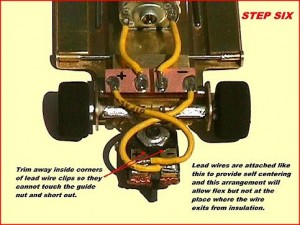 STEP SIX We deal with the lead wire connections and other sundry finishing touches. The lead wires are arranged in the following fashion to provide flex with out the wires breaking at the point where the wire emerges from the insulation. It also provides a self centering mechanism that really works. You don’t want the corner marshall playing around with straightening your guide flag every time it comes off and does not go in the first time. That loses you time and over all laps. Make sure the guide shoe is threaded all the way down 10/32. Then make sure the guide shoe shaft hole in the chassis is not binding on the shaft. If you can obtain the new Parma guide shoe called the blade, it has a much better shape to the blade part. Tighten down the guide nut all the way when mounting the shoe and then back it off about a 1/2 turn or so. It must allow the guide shoe to swing back and forth freely with out any binds. Ream or file it a bit if it is tight.
STEP SIX We deal with the lead wire connections and other sundry finishing touches. The lead wires are arranged in the following fashion to provide flex with out the wires breaking at the point where the wire emerges from the insulation. It also provides a self centering mechanism that really works. You don’t want the corner marshall playing around with straightening your guide flag every time it comes off and does not go in the first time. That loses you time and over all laps. Make sure the guide shoe is threaded all the way down 10/32. Then make sure the guide shoe shaft hole in the chassis is not binding on the shaft. If you can obtain the new Parma guide shoe called the blade, it has a much better shape to the blade part. Tighten down the guide nut all the way when mounting the shoe and then back it off about a 1/2 turn or so. It must allow the guide shoe to swing back and forth freely with out any binds. Ream or file it a bit if it is tight.
Trim the inside rear edges of the lead wire mounting clips about 45 degrees. This insures the ends cannot hit the guide shoe nut and short out. I have seen a number of cars that ran intermittently because of this occurring.
The next items should finish up the car.
We show in picture seven,
the down stop to prevent the Iso center section from dropping down too far. Just S bend some .047 music wire and solder to the center section so that when the center section drops the wire piece will limit travel by hitting the front body mount tube.
Next, picture eight, shows the two curved L shape .047 music wire braces added to reinforce the rear axle uprights to the rear of the motor mount plate. Solder in well.
Picture number nine shows the bottom and the cooling hole. Measure the motor opening and transfer dimensions to the bottom of the chassis. Drill a 3/16th hole at each end anduse a file or Dremel burr to connect the two holes into the cooling hole for the motor.
As a final step, when all done and ready to send off to the race, solder the motor to the frame at the rear motor mount plate on both sides and top. Make sure the gear mesh is as you want it and then solder. If you are really worried about the motor moving, add a .047 L shaped piece to each side of the motor front bearing holder and solder to the frame so that they limit any side to side movement of the front of the motor. Your frame should now be bullet proof for the race.
Since I do molds for ToyTech, I used the ToyTech Momo Audi GTP. It was entered in several races, practiced and even started one race in Europe but was with drawn due to a lack of horsepower. I though it was a good looking body so I made the mold for it.
1. Front axles are made from one 3/32nd (.093) hardened axle cut into one inch lengths to be used as the stub axles, with 1/8 inch Dia. x 3/32nd inch long brass tube collars on each end with about .032 of the axle showing on one end after soldering the collars to the axle. Cut them off with a Dremel tool with a cut off disk and proceed slowly with good eye protection from the sparks. Remove any burrs with the side of the cut off disk and square up the ends this way also as you rotate them slowly.
2. The front wheels are Pro Track Nascar hard rubber trimmed down to 3/8 inch wide by .700-750 dia depending on class Trim the front side of the wheel so the width of the wheel will be offset over the set screw. This allows you more room to adjust the width to the car overall width. Other wise trimming to the rear, will make the set screw hub part of the width and you can’t get the tire down to 3/8 wide for the Prototype class. This may work fine for the production class where you only have to be .250 wide. The Pro Track part number is #266 these are .093 axle x .500 wide x .820 Diameter. The inside hub Diameter is .450 which then takes a fly insert with a bit of trimming easily. They are also drilled and look nice without inserts. Your choice.
3. Rear wheels shown are JK part # JK8515 But watch out, I ordered 4 sets and two came with .450 inside hub diameter which is fine for the inserts but two of the sets came with a .358 hub which is too small for nice inserts. They both had the same part #. They may have been mismatched. Will have to check on this. These come as .125 axle diameter x .810 wide x .840 diameter so you have room to trim. to what ever size you need. They are not fish rubber so will not have extreme grip and should work fine on Bobs track.
4. Some asked also how do I make the fly inserts. I used the Fly Joest wheels from the Joest. These are the BBS replicas. I take the wheel upside down on a table and use a .500 dia rod as a punch and just push the center of the fly wheel out. They come out fairly easy don’t hit them with a hammer as you can mash them. Once out I take a .093 axle and insert in the back of the Fly insert and CYA it to the axle. I let it dry for a few hours and then mount in my lathe, you can use a drill press or hand drill held in a vise. Then with a file or sand paper trim the insert down to .450 diameter. I then glue the insert into the wheel hub with a small amount of RTV clear rubber. This holds them in well. They then can be removed when the tire wears out with out too much trouble and be reused again. This should answer most of the questions I have gotten. If you have more be sure and ask.
9/2/99 – After testing the Proxy car from the article, I decided to make a couple changes for durability and to free it up a bit in the rear. So I have updated the Step Three picture and some dimensions in the text for that and for the front tube mounts they are listed now in red in the text.
Good luck.
Larry Shephard
The Old Weird Herald







